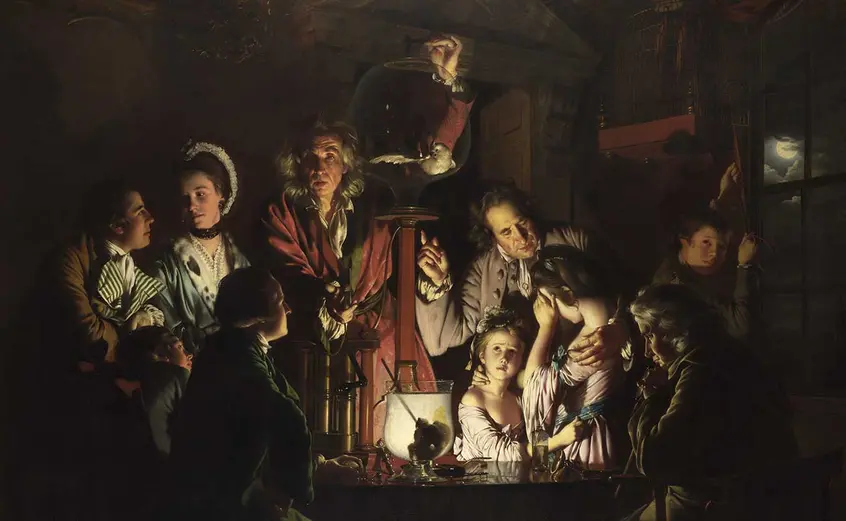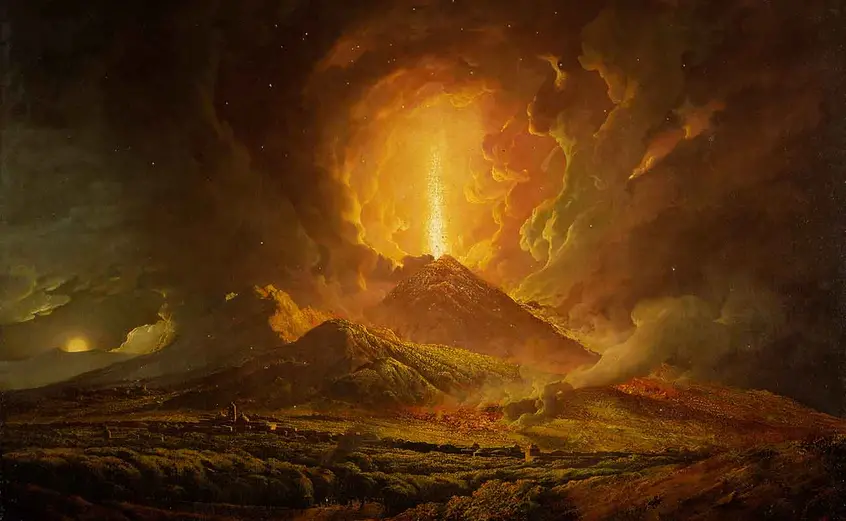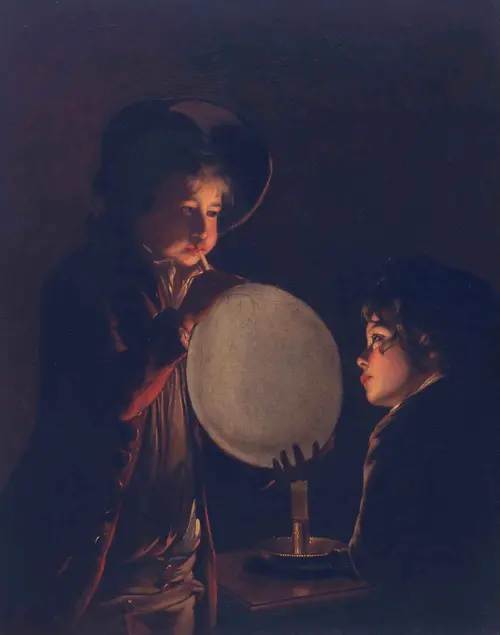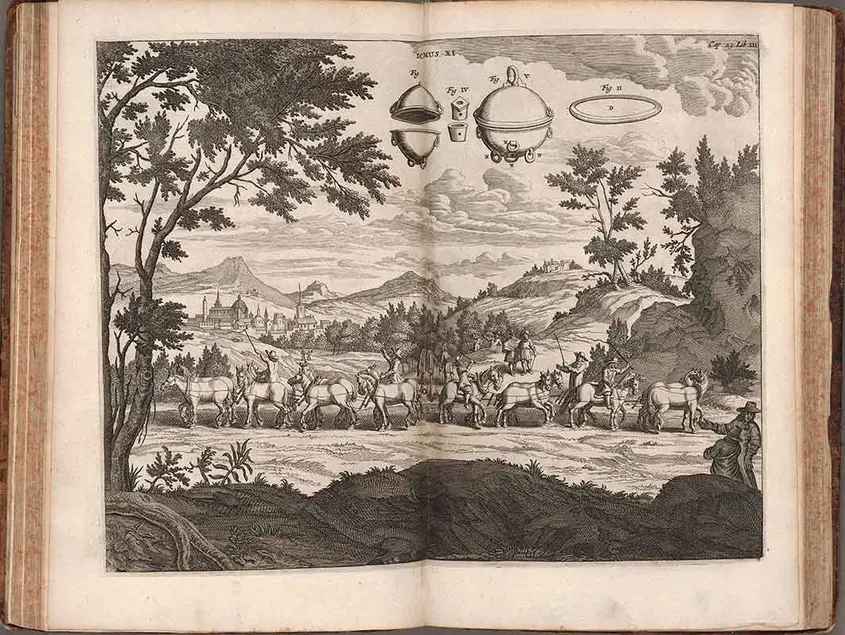Joseph Wright of Derby’s An Experiment on a Bird in the Air Pump (1768) will be installed in the context of two strengths of The Huntington’s collections: British art and the history of science “Science and the Sublime: A Masterpiece by Joseph Wright of Derby”
Updated: On view Feb. 12–May 30, 2022 | Huntington Art Gallery, North Passage
SAN MARINO, Calif.—One of the great masterpieces from the Age of Enlightenment, Joseph Wright of Derby’s An Experiment on a Bird in the Air Pump (1768) will be shown at The Huntington Library, Art Museum, and Botanical Gardens from Feb. 12 through May 30, 2022, in an installation titled “Science and the Sublime: A Masterpiece by Joseph Wright of Derby.” The monumental 6-by-8-foot work will be lent by the National Gallery in London, where it is one of that institution’s most popular paintings.
The powerful scene depicts a small group of people gathered around a candlelit table on which a lecturer in natural history is performing a scientific experiment, namely the creation of a vacuum, as described by chemist Robert Boyle in the 17th century. As air is slowly removed from a glass jar, the fate of a cockatiel inside the jar hangs in the balance. The observers’ reactions range from fascination to dismay. In Wright’s hands, the tableau is an exercise in the sublime, a moment of extreme tension recast as a dramatic meditation on the fragility of life. At the same time, the experiment being performed relates to advances in the fields of science and medicine, making the scene a celebration of human achievement.
The loan of Bird in the Air Pump is part of a reciprocal exchange with the National Gallery, where The Huntington’s most famous work, Thomas Gainsborough’s iconic portrait of The Blue Boy (ca. 1770), will be on display for London museumgoers for the first time in a century, from Jan. 25 through May 15, 2022.
“We’re very excited to be partnering with the National Gallery for the first time in these reciprocal loans, which give audiences on both sides of the Atlantic a rare opportunity to view important works that have strong connections to each museum’s respective collections,” said Christina Nielsen, the Hannah and Russel Kully Director of the Art Museum at The Huntington. “It’s also a wonderful opportunity to collaborate within The Huntington’s own collecting areas to forge deeper connections between the holdings of the Art Museum and the Library.”
The Huntington’s “Science and the Sublime” exhibition will feature 15 works from the institution’s permanent collections, including two smaller paintings by Wright and 13 rare objects from the Library’s holdings.
The exhibition’s theme highlights two major strengths of The Huntington’s collections—British art and the history of science—providing a unique opportunity to juxtapose materials that are not normally displayed together. It also capitalizes on the great educational potential of these combined materials. Alongside Bird in the Air Pump, rare books and ephemera will reveal the real science behind the elements that Wright depicts on canvas and the contemporary moral and aesthetic debates with which he engages.
“Wright’s paintings often tap into notions of the sublime, an aesthetic category described by philosopher Edmund Burke as producing the strongest emotions the mind is capable of, such as awe or terror, but in a way that causes pleasure,” said Melinda McCurdy, curator of British art at The Huntington. “The thrill of the sublime can be found in nature, in things of immense size, like great mountains, or that are dangerous or unknown, like deep chasms or dark caves. When Wright paints an erupting volcano, for example, or a scientific experiment that explores questions of life or death, he is evoking the sublime to create an emotional reaction in his audience.” Wright’s dramatic painting Vesuvius from Portici (ca. 1774–76), from The Huntington’s permanent collection, will also be on view in the exhibition.
Monumental scientific paintings, such as An Experiment on a Bird in the Air Pump, are a form of British art that’s not represented in The Huntington’s collections. The exhibition, therefore, is an opportunity to introduce Art Museum visitors to historical thinking about science and the implications of scientific process as well as to draw those interested in science and history. Accompanying the exhibition will be a number of rare works from the Library’s holdings that closely relate to the subject of the painting and were likely familiar to Wright. Prominent among these are Robert Boyle’s New experiments physico-mechanicall, touching the spring of the air, and its effects, a second edition from 1662, and Otto von Guericke’s Experimenta nova (ut vocantur) magdeburgica de vacuo spatio (The new [so called] Magdeburg experiments in the vacuum of space), published in 1672.
Joel Klein, The Huntington’s Molina Curator for the History of Medicine and Allied Sciences, notes that many earlier scientists and philosophers, following the teachings of Aristotle, believed that a vacuum in nature was an impossibility. “When Robert Boyle and other fellows of the newly formed Royal Society of London used the recently invented air pump to show that vacuums can exist and that air pressure is inversely related to its volume, it was transformative,” said Klein. “Boyle and his collaborators also used the air pump to study the nature of air, showing its effects on animal respiration as well as combustion.” But beyond this, the air pump—as pictured in Boyle’s New experiments physico-mechanicall—became emblematic of a new experimentalism that relied on similar machines to produce knowledge via demonstrations among witnesses, such as in the scene depicted by Wright.
Boyle and his colleagues were not the first to use an air pump, said Klein, nor were they the first to recognize that it could be used to produce natural knowledge. In 1654, German scholar von Guericke (the inventor of the air pump) conducted an extraordinary experiment in which two large copper hemispheres that fit together to form an empty sphere were sealed with grease, then the air was pumped out to create a vacuum within. Thirty horses attempted to pull the hemispheres apart—to no avail. An engraving of this famous experiment from von Guericke’s published account will be on view alongside Boyle’s work.
These scientific advances were not without controversy or moral implications. Klein notes that Boyle himself was troubled by the suffering inflicted on animals in his experiments—and the public was, too. “Criticism of such experimentation was an important factor in the rise of anti-vivisectionist groups opposed to cruelty to animals in the early 19th century,” said Klein.
Other works on view in the exhibition include Wright’s Two Boys by Candlelight, Blowing a Bladder (ca. 1767–73), which shows a pair of youngsters creating a makeshift balloon from a pig’s bladder. The painting emphasizes Wright’s continuing interest in the use of lighting to create a dramatic effect—something he did with such success in Bird in the Air Pump, McCurdy notes. “I would argue, in fact, that the subject of the painting is not so much the boys and their activity as the effect of light,” she said. “Wright even experimented with unusual materials in this painting to get the effect—and the audience reaction—he wanted. Underneath the paint layer of the bladder, there is a thin layer of silver leaf, which Wright applied to add luminosity to the area to mimic the glow of candlelight through the thin membrane.”
Related to the exhibition: A series of public programs will be presented during the run of the exhibition to enhance the gallery experience. These include a lecture on March 9, 2022, by David Solkin, professor emeritus of the Courtauld Institute of Art and one of the leading experts on the history of British art; and a lecture on April 13, 2022, by Tita Chico, professor of English at the University of Maryland, exploring the links between literature and science in the 18th century. Details to be announced.
###
Contacts
Thea M. Page, The Huntington, 626-405-2260, tpage@huntington.org
Tracy Jones, The National Gallery, +44(0)7785-525909, tracy.jones@ng-london.org.uk
About The Huntington
The Huntington Library, Art Museum, and Botanical Gardens, a collections-based research and educational institution, aspires to be a welcoming place of engagement and reflection for a diverse community. The Huntington is located at 1151 Oxford Road, San Marino, California, 12 miles from downtown Los Angeles. Visitor information: huntington.org or 626-405-2100. (Check huntington.org for updates on new visitation protocols due to COVID-19.)
About the National Gallery
The National Gallery is one of the greatest art galleries in the world. Founded by Parliament in 1824, the Gallery houses the nation’s collection of paintings in the Western European tradition from the mid-13th to early 20th century. The collection includes works by Bellini, Cézanne, Degas, Leonardo, Monet, Raphael, Rembrandt, Renoir, Rubens, Titian, Turner, Van Dyck, Van Gogh, and Velázquez. The Gallery’s key objectives are to enhance the collection, care for the collection, and provide the best possible access to visitors. Admission is free. More at nationalgallery.org.uk.



![Illustration. From Robert Boyle (1627-1691), New experiments physico-mechanical, touching the spring of the air and its effects [2nd edition], 1662. Printed book. The Huntington Library, Art Museum, and Botanical Gardens.](/sites/default/files/styles/image_gallery/public/press-room/images/4_robert_boyle_physico-mechanical_1662.jpg.webp?itok=PkEgGpI8)




![Illustration. From Robert Boyle (1627-1691), New experiments physico-mechanical, touching the spring of the air and its effects [2nd edition], 1662. Printed book. The Huntington Library, Art Museum, and Botanical Gardens.](/sites/default/files/styles/image_gallery_thumbnail/public/press-room/images/4_robert_boyle_physico-mechanical_1662.jpg.webp?itok=RhmWdQCR)
